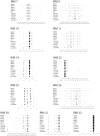Panmixia in a fragmented and unstable environment: the hydrothermal shrimp Rimicaris exoculata disperses extensively along the Mid-Atlantic Ridge
- PMID: 22679511
- PMCID: PMC3367947
- DOI: 10.1371/journal.pone.0038521
Panmixia in a fragmented and unstable environment: the hydrothermal shrimp Rimicaris exoculata disperses extensively along the Mid-Atlantic Ridge
Abstract
Dispersal plays a fundamental role in the evolution and persistence of species, and especially for species inhabiting extreme, ephemeral and highly fragmented habitats as hydrothermal vents. The Mid-Atlantic Ridge endemic shrimp species Rimicaris exoculata was studied using microsatellite markers to infer connectivity along the 7100-Km range encompassing the sampled sites. Astonishingly, no genetic differentiation was found between individuals from the different geographic origins, supporting a scenario of widespread large-scale dispersal despite the habitat distance and fragmentation. We hypothesize that delayed metamorphosis associated to temperature differences or even active directed migration dependent on physical and/or chemical stimuli could explain these results and warrant further studies on adaptation and dispersal mechanisms.
Conflict of interest statement
Figures



Similar articles
-
De novo transcriptome assembly of the deep-sea hydrothermal vent, shrimp Rimicaris exoculate (Crustacea: Decapoda), from the south Mid-Atlantic Ridge.Mar Genomics. 2021 Dec;60:100876. doi: 10.1016/j.margen.2021.100876. Epub 2021 May 3. Mar Genomics. 2021. PMID: 33958310
-
Molecular systematics of shrimp (Decapoda: Bresiliidae) from deep-sea hydrothermal vents, I: Enigmatic "small orange" shrimp from the Mid-Atlantic Ridge are juvenile Rimicaris exoculata.Mol Mar Biol Biotechnol. 1998 Jun;7(2):88-96. Mol Mar Biol Biotechnol. 1998. PMID: 9628005
-
"Candidatus Desulfobulbus rimicarensis," an Uncultivated Deltaproteobacterial Epibiont from the Deep-Sea Hydrothermal Vent Shrimp Rimicaris exoculata.Appl Environ Microbiol. 2020 Apr 1;86(8):e02549-19. doi: 10.1128/AEM.02549-19. Print 2020 Apr 1. Appl Environ Microbiol. 2020. PMID: 32060020 Free PMC article.
-
Dual symbiosis of the vent shrimp Rimicaris exoculata with filamentous gamma- and epsilonproteobacteria at four Mid-Atlantic Ridge hydrothermal vent fields.Environ Microbiol. 2010 Aug;12(8):2204-18. doi: 10.1111/j.1462-2920.2009.02129.x. Epub 2009 Dec 27. Environ Microbiol. 2010. PMID: 21966914
-
Gene flow and genetic diversity in naturally fragmented metapopulations of deep-sea hydrothermal vent animals.J Hered. 1997 Jul-Aug;88(4):285-93. doi: 10.1093/oxfordjournals.jhered.a023106. J Hered. 1997. PMID: 9262010 Review.
Cited by
-
The role of the Strait of Gibraltar in shaping the genetic structure of the Mediterranean Grenadier, Coryphaenoides mediterraneus, between the Atlantic and Mediterranean Sea.PLoS One. 2017 May 1;12(5):e0174988. doi: 10.1371/journal.pone.0174988. eCollection 2017. PLoS One. 2017. PMID: 28459855 Free PMC article.
-
Comparative population structure of two dominant species, Shinkaia crosnieri (Munidopsidae: Shinkaia) and Bathymodiolus platifrons (Mytilidae: Bathymodiolus), inhabiting both deep-sea vent and cold seep inferred from mitochondrial multi-genes.Ecol Evol. 2016 Apr 23;6(11):3571-3582. doi: 10.1002/ece3.2132. eCollection 2016 Jun. Ecol Evol. 2016. PMID: 28725351 Free PMC article.
-
Comparative Population Genomics Unveils Congruent Secondary Suture Zone in Southwest Pacific Hydrothermal Vents.Mol Biol Evol. 2025 Feb 3;42(2):msaf024. doi: 10.1093/molbev/msaf024. Mol Biol Evol. 2025. PMID: 39882942 Free PMC article.
-
LTR-retrotransposons in R. exoculata and other crustaceans: the outstanding success of GalEa-like copia elements.PLoS One. 2013;8(3):e57675. doi: 10.1371/journal.pone.0057675. Epub 2013 Mar 4. PLoS One. 2013. PMID: 23469217 Free PMC article.
-
High genomic connectivity within Anatoma at hydrothermal vents along the Central and Southeast Indian Ridge.Sci Rep. 2025 Jan 15;15(1):1971. doi: 10.1038/s41598-025-85507-z. Sci Rep. 2025. PMID: 39809848 Free PMC article.
References
-
- Van Dover CL, German CR, Speer KG, Parson LM, Vrijenhoek RC. Evolution and biogeography of deep-sea vent and seep invertebrates. Science. 2002;295:1253–1257. - PubMed
-
- Moalic Y, Desbruyères D, Duarte CM, Rozenfeld AF, Bachraty C, et al. Syst Biol; 2011. Worldwide biogeography of hydrothermal vents revisited with network analysis. doi: 10.1093/sysbio/syr088. - DOI - PubMed
-
- Shank TM, Fornari DJ, Von Damm KL, Lilley MD, Haymon, RM, et al. Temporal and spatial patterns of biological community development at nascent deep-sea hydrothermal vents (9°50′N, East Pacific Rise). Deep-Sea Res II. 1998;45:465–515.
-
- Jollivet D, Chevaldonné P, Planque B. Hydrothermal-vent alvinellid polychaete dispersal in the eastern Pacific. 2. A metapopulation model based on habitat shifts. Evolution. 1999;53:1128–1142. - PubMed
Publication types
MeSH terms
LinkOut - more resources
Full Text Sources

